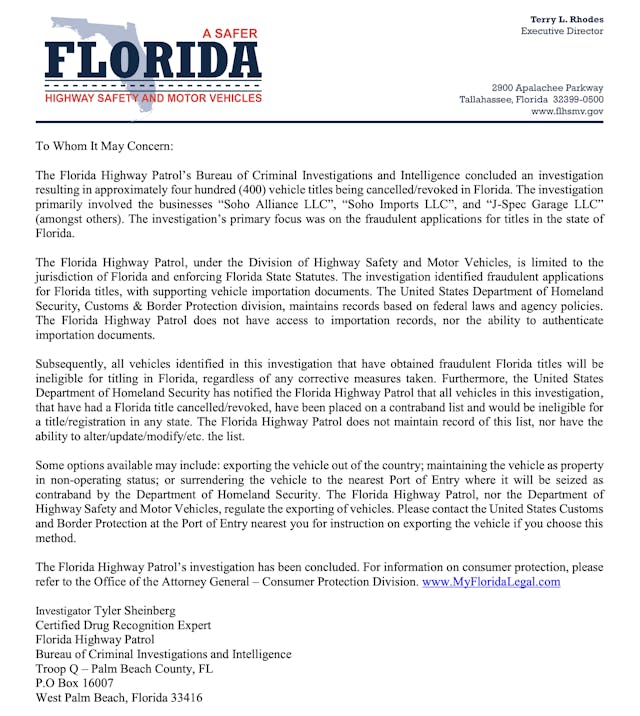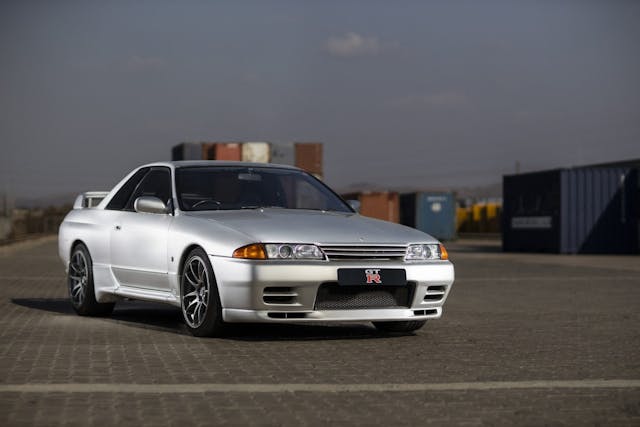Florida’s import fraud crackdown is a cautionary tale for collectors
We always want what we can’t have—maybe it’s one of those lizard-brain reactions that can’t be helped. For car enthusiasts, foreign-market performance cars have long been such an object of desire.
You’re probably aware that we in the U.S. can gain access to those forbidden-fruit Skylines and Silvias once they become older than 25 years of age. Whether you’re importing actual fruit, cars, or anything else, however, very specific rules must be followed. With collector cars, these rules create pent-up demand, motivating less-than-scrupulous importers to take shortcuts. Such was the case brought earlier this month against Andres Diaz, President of SOHO Alliance LLC of Pembroke Pines, Florida, and his associate, Nicole Chiong, who are alleged to have committed 348 instances of fraud in applying for titles for vehicles the company imported.
Not only has SOHO’s auto dealer license been revoked, but the Florida titles of those 348 cars have been as well, rendering those cars legally unable to operate in the state of Florida and subject to additional Federal import investigation.

Sean Morris is not the least bit surprised by last week’s events. As a third-generation vehicle importer and Director at Toprank International Vehicle Importers, Morris knows a thing or two about the proper way to bring a vehicle to U.S. shores. He’s also known for his involvement in sourcing cars for the Fast & Furious movie franchise, and has created numerous online resources for those interested in importing cars.
“There are plenty of people who will put a car in a container and not declare it,” Morris said. “If they’re playing the numbers, there’s a really good chance they won’t get popped for a long time.” He’s right—shipping industry studies estimate only 3-5 percent of the 11 million-plus shipping containers that enter the U.S. annually are inspected.
Those same people are all too happy to sell their wares to undereducated buyers. “[Some importers] will tell buyers that since it’s state titled, it’s good to go, but that doesn’t mean the work has been done to legally import the car,” Morris added. “Buyers are easily convinced by someone that there’s a loophole because how else could they have a car here?”
Morris indicated that some buyers are willfully aware of the shortcuts being taken while others are simply don’t put in the due diligence necessary to verify that all the proper steps have been completed. What’s more, any subsequent sales after the first Stateside owner can further muddy the waters—absent retaining all the proper importing documentation (not to mention knowing exactly what paperwork to look for), it can become increasingly challenging to ensure that the R32 you just bought won’t suddenly cause Homeland Security to come calling. Yes, you read that right: If the Feds discover that your vehicle was not properly imported, even if you are a subsequent owner who had nothing to do with the importing process, that car may be subject to seizure.
If the Feds do come a-knocking, there is almost no recourse. An illegally-imported car is unlikely to be crushed—that’s typically a publicity stunt reserved for high-profile cases—but it may be seized and auctioned, after which it must go to a country that does not touch U.S. borders. It may be exported, but customs may seize it at the dock, and the VIN will never be able to be legally imported back into the States. According to the press release from the Florida Department of Highway Safety and Motor Vehicles, it may be possible to retain a vehicle in non-operating status, but few owners have the luxury of turning their garage into a static museum.
For those of us in the collector car hobby, the SOHO case highlights a larger problem than those 348 cars. Our data show a dramatic increase in imported cars from Japan since 2016, with Japanese brands averaging more than 700 of the approximately 1100 cars now coming to our shores monthly. Demand has surged, and highly-motivated people willing to cut corners have taken notice—Morris believes there are significantly more illegal cars out there than just the ones highlighted in this case. Vehicle provenance has always played a role in valuing collector cars, but in this instance it can mean the difference between an appreciating asset you can enjoy and a very costly headache made from metal, rubber, and plastic.
So what's a lover of JDM masterpieces (or any other foreign-market vehicles) to do? The solution is the last word anyone likes to hear: homework.
First, check the reputation of the importer or dealer. Understand their history and reputation in the marketplace. This may sound basic, but it can save you from future hassle. Having established you're working with a solid firm, it's now time to begin your due diligence. This is still true if you plan to bid on an imported car at auction. Reputable houses have crack staff who will do everything they can to ensure that all listings are trouble-free, but issues can still sneak through.
Next, the friendly folks at NHTSA have a vehicle importing page that offers guidelines—these are worth reading whether you're importing a car or buying one that's already arrived. Paperwork is the name of the game. The seller of a car properly imported under the 25-year rule should be able to produce a copy of the following four forms: NHTSA form HS7, EPA form 3520-1, Customs Entry Summary form 7501 and Entry/Immediate Delivery Document 3461. Absence of these documents should be a giant red flag to any prospective buyer. Many states will require this paperwork to title and register your new ride.
Even after importation, the process may not be over. In California, which has heavily regulated emissions standards, you will also need to make sure that the vehicle you are buying has been brought into compliance and is accompanied by a BAR label showing it meets CARB requirements. If you live elsewhere, check with your state to see if they have any additional requirements.
Cars produced less than 25 years ago can be legally imported, but only if they qualify under the Show or Display rule. These cars must meet a very tight set of requirements even to be considered for application to the approved list. If not specifically included, then the vehicle is not eligible for early import. How specific are the requirements? Well, if you want to import an R34 Skyline GT-R, the only ones approved through Show or Display are the 1999 Skyline GT-R V-Spec finished in Midnight Purple II or the 2002 Skyline GT-R M-Spec Nür. Last but not least, if you're buying a Show or Display car that is already in the country, you will need to re-apply with NHTSA as the new owner.
Sound like a lot of work? It is. Most of us don't have the time or inclination to become experts—or even coherent—in U.S. import law. The more practical route is to hire an attorney who specializes in auto importation. This will add cost, but you're already anteing up to buy your dream car, so it's worth the peace of mind you'll get knowing a flatbed operator armed with seizure documents isn't going to one day show up in your driveway. No matter if you're the first, third, or tenth prospective owner of an imported car, it's critical to vet the vehicle's legality. Finally, don't be fooled by anyone who suggests there's a shortcut to be had—it's almost certainly too good to be true.


